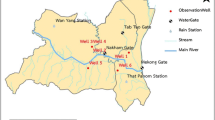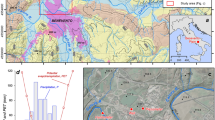Abstract
The correlation dimension (CD) of a time series provides information on the number of dominant variables present in the evolution of the underlying system dynamics. In this study, we explore, using logistic regression (LR), possible physical connections between the CD and the mathematical modeling of risk of arsenic contamination in groundwater. Our database comprises a large-scale arsenic survey conducted in Bangladesh. Following the recommendation by Hossain and Sivakumar (Stoch Environ Res Risk Assess 20(1–2):66–76, 2006), who reported CD values ranging from 8 to 11 for this database, 11 variables are considered herein as indicators of the aquifer’s geochemical regime with potential influence on the arsenic concentration in groundwater. A total of 2,048 possible combinations of influencing variables are considered as candidate LR risk models to delineate the impact of the number of variables on the prediction accuracy of the model. We find that the uncertainty associated with prediction of wells as safe and unsafe by LR risk model declines systematically as the total number of influencing variables increases from 7 to 11. The sensitivity of the mean predictive performance also increases noticeably for this range. The consistent reduction in predictive uncertainty coupled with the increased sensitivity of the mean predictive behavior within the universal sample space exemplify the ability of CD to function as a proxy for the number of dominant influencing variables. Such a rapid proxy, based on non-linear dynamic concepts, appears to have considerable merit for application in current management strategies on arsenic contamination in developing countries, where both time and resources are very limited.



Similar content being viewed by others
References
Afifi AA, Clark V (1984) Logistic regression in computer-aided multivariate analysis. Lifetime Learning Publications, Belmont
Ahmed KM, Bhattacharya P, Hasan MA, Akhter SH, Alam SMM, Bhuyian MA, Imam MB, Khan AA, Sracek O (2004) Arsenic enrichment in groundwater of the alluvial aquifers in Bangladesh: an overview. Appl Geochem 19:181–200
Akai J, Izumi K, Fukuhara H, Masuda H, Nakano S, Yoshimura T, Ohfuji H, Anawar MH, Akai K (2004) Mineralogical and geomicrobiological investigations on groundwater arsenic enrichment in Bangladesh. Appl Geochem 19:215–230
Biswas BK, Dhar RK, Samantha G, Mandal BK, Chakraborti D, Faruk I, Islam KS, Chowdury M, Islam A, Roy S (1998) Detailed study report of Samta, one of the arsenic-affected villages of Jessore District, Bangladesh. Curr Sci 74:134–145
Burgess WG, Burren M, Perrin J, Ahmed KM (2000) Constraints on sustainable development of arsenic-bearing aquifers in southern Bangladesh. Part 1: A conceptual model of arsenic in the aquifer. In: Hiscock, Rivett, Davison (eds) Sustainable groundwater development, vol 193. Geological Society of London Special Publication, pp 145–163
Christakos G, Li X (1998) Bayesian maximum entropy analysis and mapping: a farewell to kriging estimators? Math Geol 30(4):435–462
Faybishenko B (2002) Chaotic dynamics in flow through unsaturated fractured media. Adv Water Resour 25(7):793–816
Fraedrich K (1986) Estimating the dimensions of weather and climate attractors. J Atmos Sci 43:419–432
Ghilardi P, Rosso R (1990) Comment on ‘Chaos in rainfall.’ Water Resour Res 26(8):1837–1839
Grassberger P, Procaccia I (1983) Measuring the strangeness of strange attractors. Physica D 9:189–208
Hao B-L (1984) Chaos. World Scientific, Singapore
Harvey CF, Swartz CH, Badruzzaman ABM, Keon-Blute N, Yu W, Ali MA, Jay J, Beckie R, Niedan V, Brabander D, Oates PM, Ashfaque KN, Islam S, Hemond HF, Ahmed MF (2002) Arsenic mobility and groundwater extraction in Bangladesh. Science 298:1602–1606
Helsel DR, Hirsch RM (1992) Statistical methods in water resources. Elsevier, New York
Hossain F, Sivakumar B (2006) Spatial pattern of arsenic contamination in shallow tubewells of Bangladesh: regional geology and nonlinear dynamics. Stoch Environ Res Risk Assess 20(1–2):66–76. DOI 10.1007/s00477–0055-0012-7
Hossain F, Bagtzoglou AC, Nahar N, Hossain MD (2006a) Statistical characterization of arsenic contamination in shallow tube wells of western Bangladesh. Hydrol Process 20(7):1497–1510. DOI 10.1002/hyp.5946
Hossain F, Hill J, Bagtzoglou AC (2006b) Geostatistically based management of arsenic contaminated ground water in shallow wells of Bangladesh. Water Resour Manage (in press). DOI 10.1007/s11269–006–9079–2
Journel AG, Huijbregts CJ (1978) Mining Geo-statistics. Academic, San Diego
Lambrakis N, Andreou AS, Polydoropoulos P, Georgopoulos E, Bountis T (2000) Nonlinear analysis and forecasting of a brackish karstic spring. Water Resour Res 36(4):875–884
McArthur JM, Ravenscroft P, Safiullah S, Thirlwall MF (2001) Arsenic in groundwater: testing pollution mechanisms for sedimentary aquifers in Bangladesh. Water Resour Res 37(1):109–117
McArthur JM, Banerjee DM, Hudson-Edwards KA, Mishra R, Purohit R, Ravenscroft P, Cronine A, Howarth RJ, Chatterjee A, Talukder T, Lowry D, Houghton S, Chadha DK (2004) Natural organic matter in sedimentary basins and its relation to arsenic in anoxic ground water: the example of West Bengal and its worldwide implications. Appl Geochem 19:1255–1293
Mukherjee AB, Bhattacharya P (2002) Arsenic in groundwater in the Bengal Delta plain: slow poisoning in Bangladesh. Environ Rev 9:189–220
Nerenberg MAH, Essex C (1990) Correlation dimension and systematic geometric effects. Phys Rev A 42(12):7065–7074
Ormsby T, Napolean E, Burke R, Feaster L, Groessl C (2004) Getting to know ArcGIS desktop, 2nd edn. ESRI Press, Redlands (ISBN:1–58948–083-X)
Porporato A, Ridolfi L (1997) Nonlinear analysis of river flow time sequences. Water Resour Res 33(6):1353–1367
Rodriguez-Iturbe I, De Power FB, Sharifi MB, Georgakakos KP (1989) Chaos in rainfall. Water Resour Res 25(7):1667–1675
Schertzer D, Tchiguirinskaia I, Lovejoy S, Hubert P, Bendjoudi H (2002) Which chaos in the rainfall-runoff process? A discussion on ‘Evidence of chaos in the rainfall-runoff process’ by Sivakumar et al. Hydrol Sci J 47(1):139–147
Schreiber T, Kantz H (1996) Observing and predicting chaotic signals: is 2% noise too much? In: Krastov Yu A, Kadtke JB (eds) Predictability of complex dynamical systems. Springer, Berlin Heidelberg New York, pp 43–65
Serre ML, Kolovos A, Christakos G, Modis K (2003) An application of the holistochastic human exposure methodology to naturally occurring arsenic in Bangladesh drinking water. Risk Anal 23(3):515–528
Sivakumar B (2000) Chaos theory in hydrology: important issues and interpretations. J Hydrol 227(1–4):1–20
Sivakumar B (2004a) Chaos theory in geophysics: past, present and future, Chaos, Solitons. Fractals 19(2):441–462
Sivakumar B (2004b) Dominant processes concept in hydrology: moving forward. Hydrol Process 18:2349–2353
Sivakumar B (2005) Correlation dimension estimation of hydrologic series and data size requirement: myth and reality. Hydrol Sci J 50(4):591–604
Sivakumar B, Phoon KK, Liong SY, Liaw CY (1999) A systematic approach to noise reduction in chaotic hydrological time series. J Hydrol 219(3–4):103–135
Sivakumar B, Berndtsson R, Persson M (2001a) Monthly runoff prediction using phase-space reconstruction. Hydrol Sci J 46(3):377–387
Sivakumar B, Sorooshian S, Gupta HV, Gao X (2001b) A chaotic approach to rainfall disaggregation. Water Resour Res 37(1):61–72
Sivakumar B, Berndtsson R, Olsson J, Jinno K (2002a) Reply to ‘which chaos in the rainfall-runoff process?’ by Schertzer et al. Hydrol Sci J 47(1):149–158
Sivakumar B, Jayawardena AW, Fernando TM GH (2002b) River flow forecasting: use of phase-space reconstruction and artificial neural networks approaches. J Hydrol 265(1–4):225–245
Sivakumar B, Persson M, Berndtsson R, Uvo CB (2002c) Is correlation dimension a reliable indicator of low-dimensional chaos in short hydrological time series? Water Resour Res 38(2). DOI 10.1029/2001WR000333
Sivakumar B, Harter T, Zhang H (2005) Solute transport in a heterogeneous aquifer: a search for nonlinear deterministic dynamics. Nonlin Process Geophys 12:211–218
Takens F (1981) Detecting strange attractors in turbulence. In: Rand DA, Young LS (eds) Dynamical systems and turbulence, lecture notes in mathematics, vol 898. Springer, Berlin Heidelberg New York, pp 366–381
Theiler J (1987) Efficient algorithm for estimating the correlation dimension from a set of discrete points. Phys Rev A 36(9):4456–4462
Tsonis AA, Triantafyllou GN, Elsner JB, Holdzkom JJ II, Kirwan AD Jr (1994) An investigation of the ability of nonlinear methods to infer dynamics from observables. Bull Am Meteorol Soc 75:1623–1633
Twarakavi NKC, Kaluarachchi JJ (2006) Arsenic in ground waters of conterminous United States: assessment, health risk, and costs for MCL compliance. J Am Water Resour Assoc 42(2):275–294
van Geen A, Zheng Y, Vesteeg R, Stute M, Horneman A, Dhar R, Steckler M, Gelman A, Ahsan H, Graziano JH, Hussain I, Ahmed KM (2003) Spatial variability of arsenic in 6000 tube wells in a 25 km2 area of Bangladesh. Water Resour Res 39(5):1140. DOI 10.1029/2002/WR001617
Welch AH, Westjohn DB, Helsel DR, Wanty RB (2000) Arsenic in ground water of the United States: occurrence and geochemistry. Ground Water 38(4):589–604
Yu WH, Harvey CM, Harvey CF (2003) Arsenic groundwater in Bangladesh: a geo-statistical and epidemiological framework for evaluating health effects and potential remedies. Water Resour Res 39(6):1146. DOI 10.1029/2002WR001327
Zheng Y, Stute M, van Geen A, Gavrieli I, Dhar R, Simpson HJ, Schlosser P, Ahmed KM (2004) Redox control of arsenic mobilization in Bangladesh groundwater. Appl Geochem 19:201–214
Author information
Authors and Affiliations
Corresponding author
Rights and permissions
About this article
Cite this article
Hill, J., Hossain, F. & Sivakumar, B. Is correlation dimension a reliable proxy for the number of dominant influencing variables for modeling risk of arsenic contamination in groundwater?. Stoch Environ Res Risk Assess 22, 47–55 (2008). https://doi.org/10.1007/s00477-006-0098-6
Published:
Issue Date:
DOI: https://doi.org/10.1007/s00477-006-0098-6




